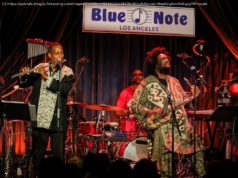It was 20 minutes past midnight when police officer Richard Overton decided he’d had enough of the teens and their rock and roll music. In…
It was 20 minutes past midnight when police officer Richard Overton decided he’d had enough of the teens and their rock and roll music.
In the police report from the night of June 2,1956, Overton wrote that the music playing at the Santa Cruz civic auditorium “excited the crowd to passion at times and it was feared the crowd might become uncontrollable.”
One couple, in particular, drew his eye. They were furiously dancing, making “highly suggestive, stimulating and tantalizing motions.” A crowd of other dancers had gathered around them, admiring their moves.
Apparently terrified of this would-be revolt of hormonal young people, Overton mustered police resources to clear out the venue. No one protested; all 200 revelers left quietly, including the band. In the light of day, Santa Cruz police chief Al Huntsman declared all future rock and roll dances were banned.
“Authorities have imposed a ban on ‘rock and roll’ and other frenzied forms of terpsichore in Santa Cruz as a result of ‘obscene and highly suggestive dancing’ by teenagers at an affair held at civic auditorium Saturday night,” the Santa Cruz Sentinel declared on its front page.
Santa Cruz had banned rock and roll. And the people would not be happy about it.
—
It only took a few days for the story to go viral, 1950s-style. Wire services around the nation picked up the tale, and the Santa Cruz police department was flooded with calls from reporters asking about the ban. The outrage came too, from young and old, who saw the move as a draconian measure to regulate fun. Many felt a racial element was also part of the police response. The band performing that night was black, the police were white.
„Because of a few bad apples, [we have] been made into a group of uncontrollable savages overpowered by the provocative rhythms,” 16-year-old Arlene Freitas wrote in a letter to the Sentinel. „… I disagree with you about the destruction of health and morals of our youth, if anything it helps by eliminating prejudice between the two races.“
The backlash hit the city hard, and officials immediately started clarifying the ban. On June 6, city manager Robert Klein announced there was no official city ban on „harmless“ rock and roll dancing.
“We have nothing against rock-and-roll music,” police chief Huntsman added. “It’s just what some people do while listening to it.”
Their backtracking led to an incredible San Francisco Chronicle article on June 7. It read: “City officials, indignant over being thought of as squares, announced today that dancing to rock and roll music is NOT being banned from this seaside resort community.”
But some busy-body city council members weren’t ready to let the issue go. After a few postponements, the issue went before the council on Aug. 28. They passed a resolution giving city auditorium manager Ray Judah the right to ban any dance “from rock n’roll to stately waltz” that he deemed “not consistent with the presentation of clean and acceptable stage and floor events, including dances of immoral and suggestive character.”
The resolution, though, didn’t have teeth. The parameters for an “immoral” dance were not specified, and the resolution only applied to the civic auditorium. The next year, the Sentinel was back to publishing photos of happy teens, dancing to rock and roll music at high school dances and local concerts.
In the end, common sense won, partly because some of the surprisingly sassy adults saw the folly of banning dances.
„I attended that dance, and with the exception of one offender, a white girl, I thought it was the tamest affair I ever saw in all my 70 years of life and dancing,“ H. C. Bollman wrote in a letter published in the Sentinel. „… I may help them put on a dance just like I saw and maybe even the same music, to show the parents, free of charge, how dead Rock and Roll is, compared to the Modern and Jazz dances during and since the Gay ’20s.“






